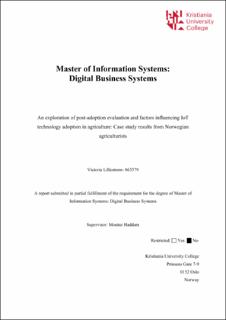| dc.description.abstract | Internet of things-based technologies have revolutionized and redesigned almost every industry, including agriculture. As the surge in global population and the increasing demand for food and water becomes more crucial in terms of both quantity and quality, IoT is providing revolutionary opportunities in the industry. Despite the great opportunities IoT can deliver, studies and researchers have found generally low adoption levels among agriculturists. In addition, IoT is still a new paradigm that has not been fully explored in the agriculture industry, compelling a need to investigate the current standings and capabilities of the new age IoT technologies.
This study aims to explore factors influencing IoT adoption, how such technologies have affected agriculturists and to reveal challenges and areas of concern that needs to be addressed in order to enhance IoT adoption. The research questions have been investigated in a multiple case study, where data is collected through individual semi-structured interviews with Norwegian agriculturists who have adopted IoT technologies. Even though some of the findings were aligned with other studies investigating IoT adoption in agriculture, several important and noteworthy differences were discovered. The findings indicates that the adoption of agricultural IoT technologies is much more complex than many previous studies have assumed, where various factors and determinants have the potential to influence the adoption, such as the degree of technical support, governmental policies and if the children of the agriculturists intend to take over the farming operations in the future.
It has also been revealed that the adoption of IoT technologies has resulted in several positive outcomes, such as improved decision-making, improved efficiency and increased control, but it is also evident that the agriculturists are not fully aware of all the consequences of adopting IoT technologies. Lastly, the findings indicate that there is a lack of support, as well as knowledge, among various stakeholders in the industry, something which has the potential to hamper the uptake of IoT technologies in the agriculture industry.
Keywords: Internet of things (IoT), Agriculture, Precision farming, Smart agriculture, Technology adoption, Post-adoption evaluation | en_US |

